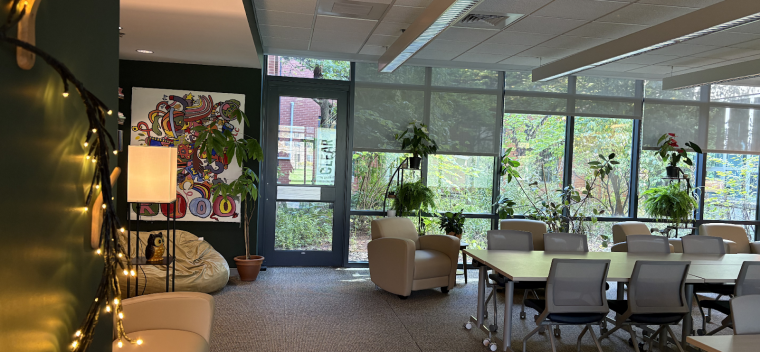The Center for Learning, Education and Research in the Sciences
History
Oberlin established the Center for Learning, Education, and Research in the Sciences (CLEAR) in 2012 through an award granted by the Howard Hughes Medical Institute (HHMI). The Center supports students in STEM gateway courses with Supplemental Instruction, homework help, and peer mentoring to lower barriers to student success in the Sciences.

CLEAR's dedicated space, K100, serves as an important resource for community building, workshops, and STEM events.

Since its inception in 2012, CLEAR has nurtured a culture of inclusivity within Oberlin's STEM community. It has empowered faculty and students alike to adopt equity-centered approaches in teaching and learning within gateway STEM courses. CLEAR fulfills its mission by providing consistent support for faculty development, curriculum enhancement, and peer leadership—which together comprise key elements in fostering resilience and retention amongst students participating in Oberlin's STEM curriculum.
The role of CLEAR on campus has grown each year as it has become more firmly integrated into Oberlin's institutional priorities, including in cultivating retention through high-impact practices. Beginning with the founding director, Marcelo Vinces, the center has provided more than just academic support for students. The Center has been instrumental in establishing a sense of belonging for students across STEM disciplines at Oberlin.
In 2017, Oberlin College became one of 24 colleges and universities nationwide awarded a $1 million grant through the Howard Hughes Medical Institute (HHMI)'s Inclusive Excellence initiative. The goal of Oberlin’s project is to promote persistence and success of all students in STEM fields by changing the ways the science community is structured and the science curriculum is delivered.
To achieve these goals, the leadership team at Oberlin has utilized this grant to reflect and rethink how students experience STEM on campus. This is achieved through a variety of ways, most prominently through listening sessions, departmental action and response teams, and the creation of a new fellowship available to recent alumni.
Building on a series of listening sessions that brought together 120 individuals from 42 offices and departments to visualize an enhanced model for inclusion, faculty and staff from across the campus formed collaborative learning communities. These communities worked to advance inclusive excellence. Departmental teams extended these efforts, implementing revised curricula focusing on introductory courses.
CLEAR’s second and third directors, Nicolette Mitchell OC ‘13 and Sabriya Rosemond, respectively, both served as core members of the HHMI leadership team and continued Vinces' work, coordinating programming for staff and faculty while placing greater emphasis on promoting equity, access, and resources for underrepresented students on campus.
In 2024, a restructuring brought two critical campus resources – the Center for Learning, Education, and Research (CLEAR) and Oberlin Undergraduate Research – into close collaboration under the broader framework of Inclusive Excellence in research and STEM education. Abby Aresty currently serves as the Interim Director of Inclusive Excellence in STEM Pedagogy and Undergraduate Research. She has sought to capitalize on this restructuring by developing a continuum of high-impact practices that support students from gateway STEM classrooms through advanced research experiences.